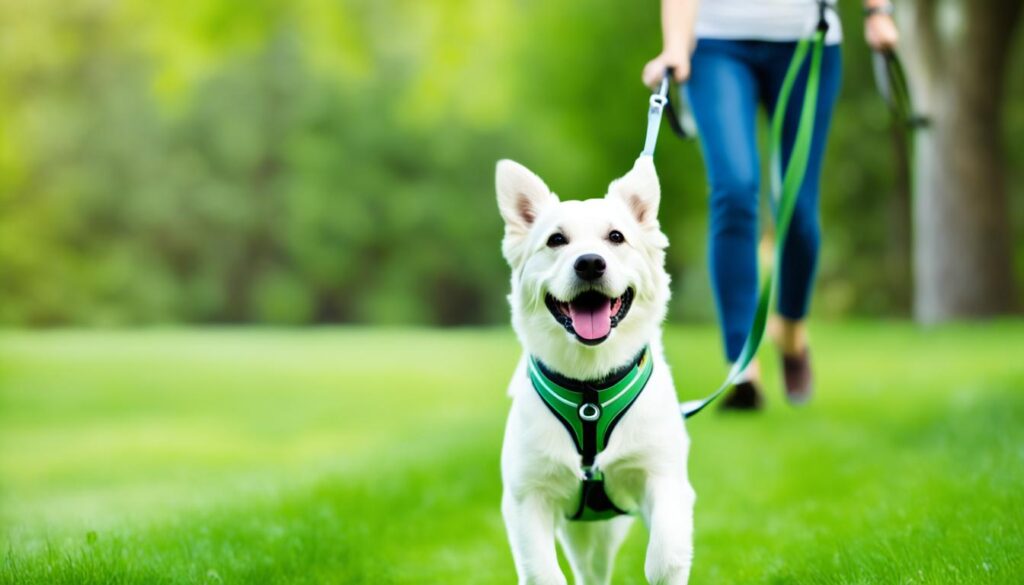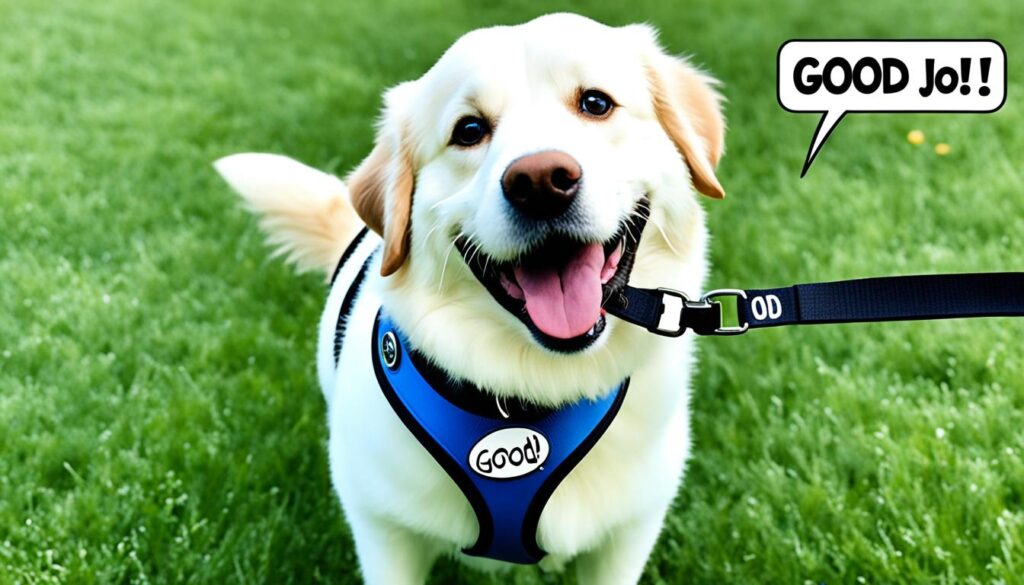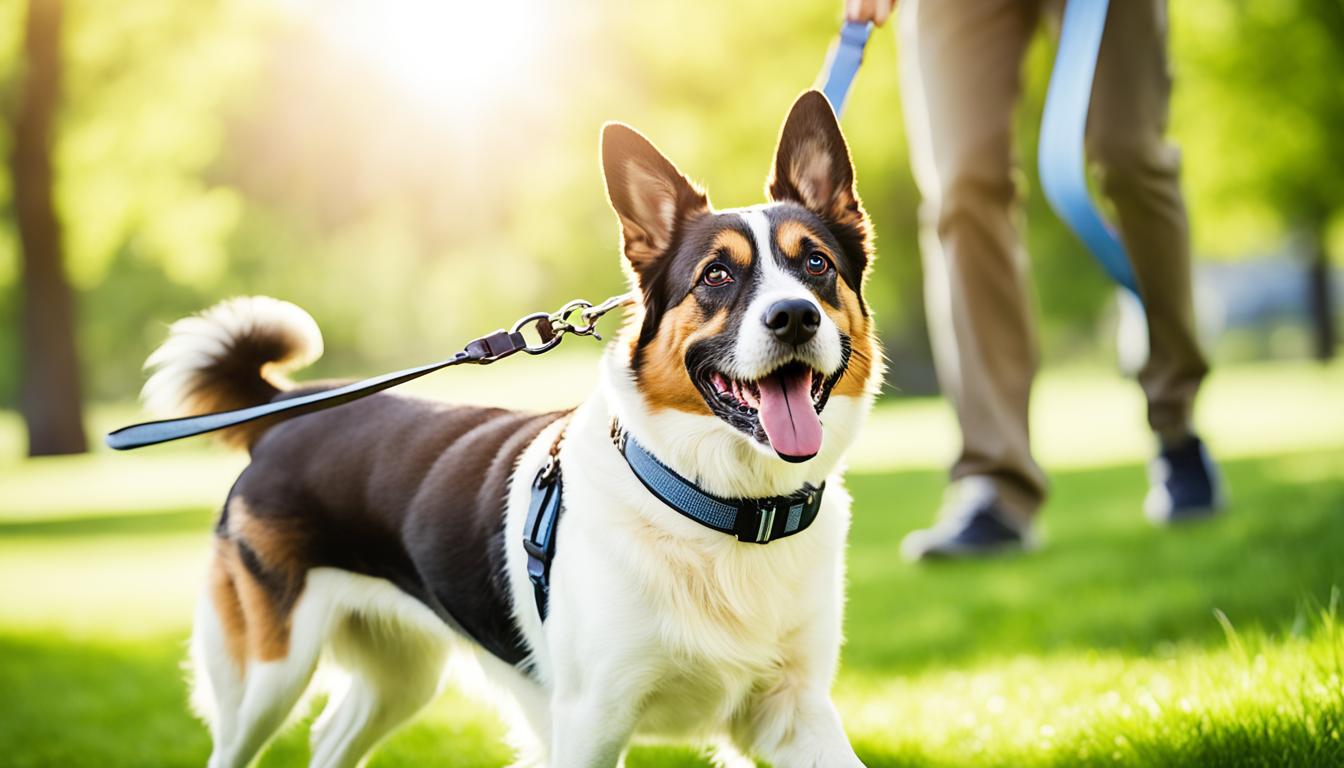As an Amazon Associate I earn from qualifying purchases.
Walking your dog is not just about getting exercise and fresh air; it’s about the special bond you share with your furry companion. But we all know that leash walking can quickly turn into a frustrating tug-of-war if your dog constantly pulls, zig-zags, or stops unexpectedly.
Believe me, I’ve been there. I used to dread taking my energetic pup, Max, for walks. It seemed like we were always on different wavelengths – he wanted to explore every fascinating scent and chase every squirrel, while I just wanted a peaceful, stress-free stroll.
But let me tell you, there’s hope! Through patience, practice, and a few tried-and-true techniques, you can turn those frustrating walks into enjoyable bonding moments with your furry friend. And the best part? It doesn’t have to be complicated or time-consuming.
Key Takeaways:
- Leash walking doesn’t have to be a struggle – implement these tips to make your walks more enjoyable.
- Stay calm and patient – remember that leash walking is a learning process for both you and your dog.
- Reward good behavior – positive reinforcement goes a long way in teaching leash manners.
- Choose the right equipment – a well-fitted collar and a standard leash can make a significant difference.
- Practice in controlled environments – gradually increase difficulty and introduce distractions.
Be a Tree and Reward Good Behavior
When it comes to leash walking, one of the most effective strategies is to be like a tree. What do we mean by that? Well, when your dog starts pulling on the leash, simply stop moving. Don’t budge an inch. This sends a clear message to your furry friend that pulling will not get them where they want to go. Wait for your dog to relax the leash, and then resume walking. This technique teaches your dog that pulling gets them nowhere and that a loose leash is the key to moving forward.
But what about when your dog walks beside you without pulling? This is the perfect opportunity to reward their good behavior. Praise them with enthusiasm, give them a tasty treat, or even use a clicker to mark the moment. Positive reinforcement is an excellent tool for encouraging loose leash walking and reinforcing good leash manners. When your dog learns that staying by your side brings rewards, they’ll be more motivated to walk politely on the leash.
Remember, leash training should be based on reward-based techniques. It’s all about teaching your dog what behaviors are desirable and rewarding them for making the right choices. By being consistent and patient, you can transform your dog’s leash manners and enjoy stress-free walks together.
Expert Tip
“Reward-based training is a powerful way to shape your dog’s behavior and teach them good leash manners. By focusing on positive reinforcement, you can create a strong bond with your dog and make leash walking an enjoyable experience for both of you.”
Quick Tips for Leash Training:
- Be consistent with your training methods and rewards.
- Use high-value treats to motivate your dog.
- Practice leash walking in various environments to generalize the behavior.
- Start with short walks and gradually increase the duration.
Choose the Right Leash and Keep the Collar High
Proper leash selection and handling are essential for successful leash walking. Start by choosing a standard leash instead of a retractable one to teach your dog proper leash etiquette. Retractable leashes can encourage pulling and make it harder to control your dog’s movement. Opt for a sturdy, fixed-length leash that allows you to maintain consistent control.
Furthermore, position the collar high on your dog’s neck to have better control and discourage pulling. Placing the collar high up on the neck, close to the base of the skull, reduces the dog’s ability to pull against the leash. This positioning takes advantage of the natural anatomical structure of the dog’s neck and gives you more leverage and control during walks.
| Leash Selection Tips | Collar Positioning Benefits |
|---|---|
|
|
By selecting the right leash and positioning the collar high, you lay the foundation for successful leash training and enjoyable walks with your furry companion.
Teach Your Dog to Not Go Ahead and Turn Around
When leash walking with your dog, it’s important to establish and reinforce proper leash etiquette. To ensure your furry friend stays close and walks beside or just behind you, implement effective dog training techniques and leash commands.
Encouraging your dog to walk beside or behind you is crucial for maintaining control and preventing pulling on the leash. One way to achieve this is by rewarding good behavior when your dog stays close to you. Positive reinforcement is a powerful tool in shaping your dog’s leash manners.
However, if your dog starts to forge ahead during the walk, don’t fret! There are a couple of strategies you can employ to redirect their attention and reinforce the desired behavior.
Blocking Technique: If your dog begins to pull ahead, use your leg to gently block their path. This physical barrier will interrupt the forward movement and remind them to stay close to you. Be consistent in using this technique to reinforce the concept of walking beside or behind you.
Turn Around Method: Another effective strategy is to turn around when your dog tries to forge ahead. By abruptly changing direction, you redirect their focus back to you. Once your dog catches up, reward them with treats and praise for staying close. This method teaches your dog that pulling ahead doesn’t lead to forward progress, encouraging them to stay by your side.
Remember, consistency is key when implementing these techniques. With practice and positive reinforcement, your dog will learn proper leash etiquette and walking behavior.
Example of Reward-based Training:
“Good job, Fluffy! You’re doing great walking beside me. Here’s a treat for staying close.”
By utilizing these training methods and leash commands, you can enjoy stress-free walks with your furry companion while reinforcing leash etiquette and promoting positive behavior.
| Leash Etiquette Techniques | Benefits |
|---|---|
| Blocking Technique | Provides a physical reminder to stay close |
| Turn Around Method | Redirects focus and encourages staying by your side |
Consider a Head Halter and Plan Your Walks
Is your dog a strong puller during walks, making it challenging to maintain control? A head halter could be the solution you’re looking for. By gently guiding your dog’s head, head halters provide effective leash control, helping to prevent pulling and improve your walking experience.
Before using a head halter, it’s important to introduce it gradually and ensure proper fitting. This will ensure your dog’s comfort and acceptance of the halter. Remember, always follow the manufacturer’s instructions and consult with a professional dog trainer for guidance if needed.
In addition to using a head halter, it’s crucial to plan your walks strategically. Start with walking routes that are free from distractions, such as busy streets or crowded areas. This will allow you and your dog to focus on the leash training process without unnecessary challenges.
As your dog becomes more adept at leash walking, gradually introduce distractions to build their tolerance and obedience. This could include walking in busier areas, encountering other dogs, or passing by enticing smells. By progressively exposing your dog to distractions, you can help them develop the skills for distraction-free walking.
| Benefits of Using a Head Halter and Planning Your Walks |
|---|
| Improved leash control |
| Prevention of pulling |
| Enhanced focus and obedience during walks |
| Gradual exposure to distractions |
Remember, consistency and patience are key when introducing a head halter and planning your walks. With time and practice, your dog will become more comfortable with the head halter and master the art of distraction-free walking.

Teach “Watch Me” and Stay Calm
When it comes to leash walking, attention training is key. Teaching your dog to make eye contact with you on command will help keep them focused and prevent distractions. And what better way to train them than with positive reinforcement?
Start by using treats and praise to reward your dog every time they make eye contact with you. Use a command like “watch me” or “focus” consistently so your dog understands what you want from them. Be patient and keep training sessions short and frequent to reinforce this behavior.
“Training a dog to make eye contact builds a strong foundation for leash walking. It helps establish a connection between you and your dog, promoting cooperation and trust.”
Additionally, it’s crucial to stay calm and composed during leash walking sessions. Dogs are incredibly perceptive and can pick up on your energy. By staying calm, you create a serene environment that encourages your dog to follow your lead.
Remember, your dog looks to you for guidance. If you become frustrated or agitated, it can confuse them and disrupt the training process. So take a deep breath, exude positivity, and keep that leash walking session a zen experience for both of you.
Benefits of Attention Training and Positive Reinforcement
| Benefits | Explanation |
|---|---|
| Improved Focus | Teaching your dog to make eye contact enhances their ability to focus on you and your commands, minimizing distractions during walks. |
| Bonding and Trust | Positive reinforcement builds a stronger bond between you and your dog, fostering trust and creating a harmonious walking partnership. |
| Reduced Leash Pulling | Attention training helps redirect your dog’s focus from pulling on the leash to maintaining eye contact with you, promoting loose leash walking. |
| Enhanced Communication | When your dog understands the “watch me” command, it becomes easier to communicate and redirect their attention when needed, creating a smoother walking experience. |
Start with a Properly Fitted Collar and Leash
When it comes to leash walking, one of the most crucial factors for success is starting with a properly fitted collar and leash. Getting the right fit ensures that you have better control over your dog and can prevent any discomfort or accidents during walks.
Collar Fitting: Take the time to measure your dog’s neck and choose a collar that fits snugly but not too tight. Too loose, and they may slip out of it; too tight, and it can cause discomfort or even injury. Remember to check the collar regularly as your dog grows or gains/loses weight.
Leash Length: The length of the leash you choose can impact how well you can control your dog during walks. For larger dogs, a longer leash allows them more freedom to explore while still giving you enough control. Smaller dogs benefit from a shorter leash that keeps them close by.
“A properly fitting collar and leash are the foundation for successful leash walking. It ensures your dog’s safety and allows you to have better control over their movements.”
Remember, a collar that fits well and a leash of the appropriate length are essential for a comfortable and controlled walking experience. With these in place, you and your furry friend can enjoy your walks together without any hassle.
| Collar Fitting | Leash Length |
|---|---|
| A properly fitted collar ensures comfort and prevents slipping. | A longer leash gives large dogs more freedom, while a shorter leash keeps smaller dogs close. |
| Avoid collars that are too tight, as they can cause discomfort or injury. | Choose a leash length appropriate for your dog’s size to have better control. |
Practice in a Controlled Environment and Use Positive Reinforcement
When it comes to leash training your dog, creating a controlled environment is key. Start in a quiet and enclosed space, such as your backyard or a quiet park, where there are minimal distractions. This will help your dog focus and build confidence in their leash walking abilities. Remember, practice makes perfect!
During your leash practice sessions, it’s important to use positive reinforcement to encourage good behavior. Positive reinforcement involves rewarding your dog for desired actions, such as walking calmly by your side without pulling. Use treats, praise, and petting as rewards to let your dog know they’re doing a great job.
“Leash training is like a dance between you and your dog. By practicing in a controlled environment and using positive reinforcement, you’ll be able to teach your pup proper leash manners while strengthening the bond between you.”
Positive training methods have been proven to be effective and humane ways of teaching your dog new behaviors. It focuses on rewarding good behavior rather than punishing unwanted behavior, creating a positive and enjoyable learning experience for both you and your furry friend.
Remember that every dog is unique, and it may take some time for them to understand and master leash walking. Be patient, consistent, and always end each training session on a positive note. With practice and positive reinforcement, your dog will soon become a leash walking pro!
Benefits of Practice in a Controlled Environment and Positive Reinforcement
Practicing in a controlled environment and using positive reinforcement has several benefits for leash training. Here are a few:
- Builds confidence: Starting in a quiet and enclosed space helps your dog feel more comfortable and confident during leash practice.
- Fosters focus: Minimizing distractions allows your dog to focus on learning and understanding leash manners.
- Strengthens the bond: Using positive reinforcement creates a positive association with leash training, strengthening the bond between you and your furry friend.
- Creates a positive learning experience: Positive training methods make learning enjoyable and encourage your dog to actively participate in training sessions.
Use a Clicker or Specific Word to Mark the Desired Behavior and Stay Consistent
Clicker training is a powerful tool to help communicate with your dog during leash training. By using a clicker or a specific word, you can mark the exact moment your dog exhibits the desired leash behavior. This clear and concise signal helps your dog understand which actions you are rewarding.
When starting clicker training, follow these steps:
- Introduce the clicker: Familiarize your dog with the clicking sound by clicking and immediately offering a treat. Repeat this several times, so your dog associates the clicker with a positive reward.
- Pair the click with desired behavior: Once your dog recognizes the clicker, use it to mark the moment your dog exhibits good leash manners. For example, if your dog walks beside you without pulling, click and reward immediately.
Consistency is key!
Consistent training is essential for successful leash walking. Ensure that everyone who walks your dog uses the same clicker or specific word to mark the desired behavior. This consistency helps your dog understand what behavior is being reinforced, making the training process more effective.
Positive reinforcement is crucial when using a clicker or specific word. Remember to reward your dog with treats, praise, or a combination of both. This positive association motivates your dog to continue exhibiting the desired leash behavior.
As you progress with clicker training, gradually reduce the frequency of using the clicker or specific word, but continue to provide consistent rewards for good leash manners.
Example Training Session:
| Step | Instruction |
|---|---|
| 1 | Attach the leash to your dog’s collar and hold it firmly. |
| 2 | Begin walking, and as soon as your dog walks without pulling, click and reward with a treat. |
| 3 | If your dog starts pulling, stop and wait until the leash is loose. Once it is relaxed, resume walking and reward your dog. |
| 4 | Repeat steps 2 and 3 during the training session, ensuring consistent use of the clicker or specific word. |
| 5 | End the session on a positive note by rewarding your dog for maintaining good leash manners. |
By incorporating clicker training and staying consistent with rewards, you can effectively teach your dog how to walk politely on a leash. Remember, patience and positive reinforcement are vital for successful leash training.

Patience is Key and Gradually Increase Difficulty
Leash walking can be a challenging endeavor, but with patience and consistency, you can achieve loose leash walking success with your furry companion. Remember, patience is key when it comes to training your dog to walk calmly on a leash. It takes time for your dog to understand the expectations and learn how to walk politely by your side.
During the early stages of training, focus on building a strong foundation and reinforcing good behavior. Start in a calm and controlled environment, such as your backyard or a quiet park, where there are minimal distractions. Patience allows your dog to progress at their own pace, building confidence and understanding.
Gradually increase the difficulty as your dog becomes more proficient in loose leash walking. Introduce challenging environments, such as a busy street or a park with other dogs nearby. By exposing your dog to these challenging situations gradually, you can help them learn to navigate distractions and maintain focus on you.
“Patience is the key to success when training your dog. Keep calm, stay consistent, and celebrate every small step forward.” – Dog Trainer
Remember to celebrate every bit of progress your dog makes, no matter how small. Positive reinforcement, such as treats and praise, helps motivate your dog and strengthens the bond between you. With time and patience, your dog will gradually learn to walk calmly by your side, even in challenging environments.
Benefits of Gradual Progress
Gradually increasing the difficulty of leash walking provides several benefits for both you and your dog. It allows your dog to develop self-control and impulse management, crucial skills that go beyond leash walking. By gradually exposing your dog to challenging situations, you are preparing them for real-life scenarios and ensuring their safety.
Furthermore, taking small steps and celebrating progress along the way helps create a positive and enjoyable training experience for both you and your dog. It builds a foundation of trust, understanding, and cooperation, making future training endeavors more successful.
Tips for Gradual Progress in Leash Walking
- Start with short walks in low-distraction environments and gradually increase both the duration of the walks and the level of distractions.
- Introduce one new distraction at a time, such as passing cars, other dogs, or bicycles, to prevent overwhelming your dog.
- Practice focusing exercises, such as “watch me,” to help your dog maintain their attention on you despite the distractions.
- Be patient and consistent with your training sessions, keeping them short and enjoyable.
| Benefits of Gradual Progress in Leash Walking | Tips for Gradual Progress |
|---|---|
| 1. Development of self-control and impulse management skills. | Start with short walks in low-distraction environments. |
| 2. Readiness for real-life scenarios and enhanced safety. | Gradually increase both walk duration and distractions. |
| 3. Positive and enjoyable training experience for both you and your dog. | Introduce one new distraction at a time. |
| Practice focusing exercises, such as “watch me.” |
Remember, every dog is unique, and progress may vary. Stay patient, celebrate the small victories, and trust the process. With gradual progress and a challenging yet supportive approach, you’ll soon enjoy peaceful and enjoyable walks with your four-legged friend.
Conclusion
Mastering the art of leash walking is essential for turning your dog’s walk into a stress-free and enjoyable experience. By implementing these dog walking tips and utilizing positive reinforcement techniques, you can help your furry friend develop proper leash manners and enhance your overall walking adventures.
Loose leash walking brings a multitude of benefits for both you and your four-legged companion. With a well-behaved dog by your side, you can explore the great outdoors without the constant pulling and tugging. You’ll have more control over your dog’s movements, ensuring their safety and the safety of those around you. Plus, you’ll be able to establish a stronger bond and deeper connection through shared activities and positive interactions.
Remember, patience is key when it comes to leash training. It takes time for your dog to learn and adjust to the new expectations. Start in a controlled environment, gradually introduce distractions, and maintain consistency in your training efforts. With dedication, practice, and a reward-based approach, you’ll soon find yourself enjoying peaceful walks with your well-behaved companion.
FAQ
What is the best strategy for leash walking?
What type of leash should I use for leash training?
How can I encourage my dog to walk beside me?
Are head halters effective for leash walking?
How can I get my dog to make eye contact during walks?
What should I consider when choosing a collar and leash?
Where should I start leash training?
How can I reinforce good leash behavior?
How long does it take to master leash walking?
What are the benefits of mastering leash walking?
Source Links
- https://fablepets.com/blogs/blog/6-tips-to-help-your-dog-master-loose-leash-walking
- https://www.goodgoodpet.com/blogs/training-tips/10-loose-leash-dog-walking-tips
- https://hahvets.com/5-steps-to-training-your-dog-to-walk-calmly-on-a-leash/
As an Amazon Associate I earn from qualifying purchases.

